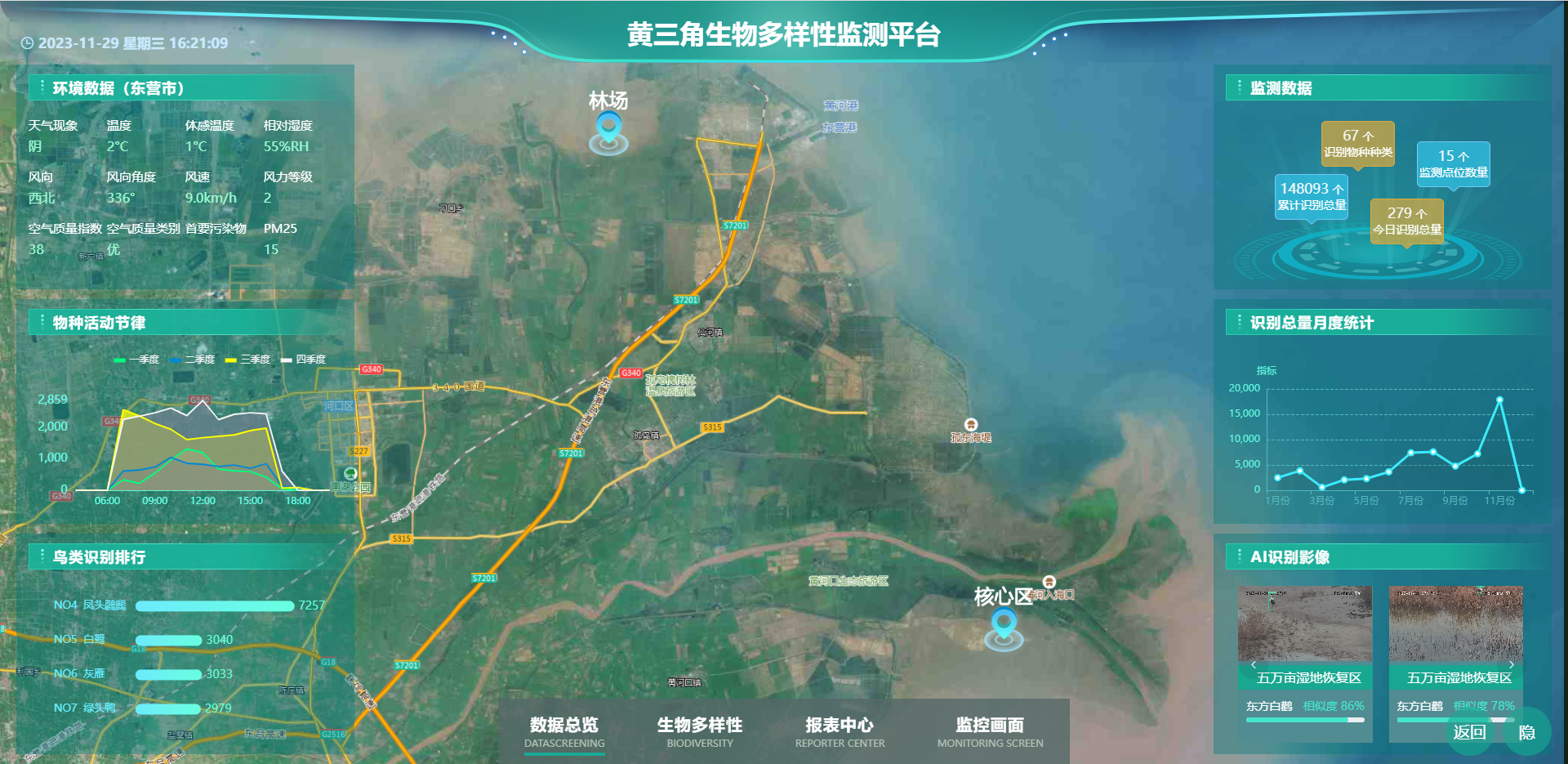China’s Wetlands: A TECH4ALL Journey to Protecting Birdlife
In 2021, I joined the Huawei TECH4ALL team in China to develop projects and solutions to help enable an inclusive and sustainable digital world.
TECH4ALL is one of Huawei's four sustainable development strategies and it aims to help achieve the UN Sustainable Development Goals. Enabled by technology and partnerships, TECH4ALL centers on developing tech solutions in four areas: education, environment, health, and development.
In May 2022, I became involved in a conservation project for migratory birds in the Yellow River Delta National Nature Reserve in China’s Shandong Province. The wetland migratory bird monitoring strategy in the province is in line with TECH4ALL’s aim to protect ecosystems and biodiversity.
But, before joining the team, I had never been involved in a nature conservation project before. The director said with a smile, "Challenge yourself. It’s meaningful to protect endangered birds with science and technology!"
So, I started collecting information about our country's protected areas and national parks.
A systematic approach
To strengthen biodiversity conservation, China is building a system for conservation, with national parks as a key feature. The country’s most important natural ecosystems, unique natural landscapes, biodiversity hotspots are gradually being incorporated into the national park system, forming a major measure for protecting natural ecology and promoting the harmonious coexistence of humans and nature.
Located in Dongying, Shandong Province, the Yellow River Delta National Nature Reserve is located on both sides of the Yellow River estuary. As one of the most extensive and well-preserved wetland ecosystems in China's temperate zone, it is also an important transit point, wintering ground, and breeding ground for migratory birds across two migratory routes: East Asia-Australasia and the western Pacific Ocean.
Our investigations showed that many nature reserves in China are in the initial stage of digitalization. Most protected areas have network connections and monitoring points, but lack the intelligent application of digital technologies. For example, monitoring systems cannot perform air-based monitoring or intelligent recognition on the data collected by cameras. Moreover, a large amount of image data sits idle on storage servers, wasting resources and not creating conservation benefits from historical image data.
Scientific researchers instead analyze images visually, creating huge workloads and greatly limiting efficiency.
To bring the Yellow River National Nature Reserve up to digital speed, Huawei TECH4ALL began working with the reserve on a tech-driven biodiversity project. In June 2022, I first visited Dongying to meet the contact for the reserve and discuss our plans for building a biodiversity monitoring platform.

I selected several core areas over 1,530 square kilometers to carry out the first phase of the monitoring pilot, whereby cameras could collect data for monitoring birds in strategic locations. After selecting several areas with the most frequent bird activities on the lakeside and beach, my colleagues from the Dongying Representative Office and I drove into the reserve for field research.
In late June, Dongying was already very hot and the air refracted on the ground to form a moving mirage on the road.
Then after an hour's trek, we arrived at the reserve and investigated the observation sites that would best capture bird breeding and living habits, selecting several sites with a wide view, no reed cover, and good observation conditions.
The wetland lives up to its name
We sorted out the hardware required for building the system and prepared to deploy cameras and servers. To avoid disturbing species or habitats, the core area of the reserve is within a protected site with no concrete roads, electricity, or wired networks. Also, it was the rainy summer months where the dirt roads in the reserve were muddy and wet, so we did our best to stay on our feet.
We could only install 5G terminals and use solar panels to power the monitoring cameras, but vehicles transporting equipment were unable to access the area and the installation progress was repeatedly delayed. I became anxious and asked the staff if there was a solution. Knowing the local area, they said, "Just watch the sky - we need three sunny days in a row, the mud will dry, and the vehicles can drive in." However, we waited about a month before the weather cleared up completely. Vehicles could finally enter, the equipment was installed, and the biodiversity monitoring system went online.
I had great expectations for this system and expected it to perform as intended.
The AI platform would be able to present the results and real-time bird recognition data visually on the system interface in the reserve. Researchers in protected areas should be able to see birds remotely, acquire data on their behaviors, and carry out conservation work more efficiently without going on site.
Bad news ahead
I reported progress to the protected area team. Surprisingly, they felt that the interface and function modules of the system were too simple and would not provide valuable insights. My colleagues and I looked at each other. We were confident in the delivery quality of phase one, but this came as a blow.
I talked to staff at the reserve, finding out that its status as a tier-one national park so expectations were very high. At the same time, problems during the first phase centered on having too few monitoring points and the fact that a large number of migratory birds had not yet arrived in the reserve as it was summer. So, video data was limited and there were insufficient datasets for training the AI model, resulting in inadequate recognition accuracy that made “the intelligent monitoring system not smart enough,” as one expert put it.
In the following months, I traveled between Beijing and Dongying many times to clarify specific requirements to improve the function design. To identify flagship species in real time and produce the analysis reports that researchers want, we worked on the visualization of monitoring labels, optimized how the data was presented, and refined various data dimensions.
After multiple version iterations, we had designed a system that the reserve was satisfied with. I breathed a sigh of relief.
Eye in the sky
Alongside insufficient sample size during non-migration months, our review showed that some birds change feathers with the season, so winter feathers and summer feathers look very different. To account for this, reserve staff and our partners provided us historical images and AI training materials, bringing the total for training the AI to 89,000 images and 54,000 videos in total.
Two weeks later, with the increase of training samples, the system's real-time recognition accuracy of birds was greatly improved. The AI could recognize 47 species with the identification accuracy for flagship species like the Oriental Stork as high as 90%. The solution not only recognizes individuals, groups, and parts of birds, but can also identify flying birds in real time.

We also optimized the interface design, data statistics, and back-end module reports of the monitoring system to more intuitively present key information such as bird migration patterns and population activity.

In September 2023, at the TECH4ALL Global Summit held during HUAWEI CONNECT, representatives from Yellow River Delta National Nature Reserve signed the second phase of the cooperation agreement with Huawei to continue to expand the scope of smart monitoring in the protected areas.
Then in October, the project won the ICT China 2023 Case Award for Excellence sponsored by the ICT China Communications Enterprise Association.
See without disturbing, guard without interfering
After the AI training in the project, I evolved into something of a bird-watching expert. I can now recognize many endangered birds at a glance and have learned many interesting facts about them. For example, the protected oriental white stork, which we’re focusing on protecting, has its own distinctive ‘red eyeliner’. With fewer than 2,500 mature individuals remaining in the world, this large wading bird - with its white feathers, black beak, and red legs - is a tier-one protected bird in China.
I also learned about the differences between oriental white storks and European storks, the different species and varied characteristics of cranes, the features of herons, how to distinguish the winter feathers and summer feathers of black-billed cranes, what kind of bird is a snipe and so on...
Dr Jane Doyle, a well-known conservationist, said, "You can only care if you understand; only through care can action be taken; There is hope in life only through action. As the sun sets, on the beautiful beach of the Yellow River estuary, countless migratory birds flock to the sky, and flocks of swans, egrets and red-crowned cranes stroll along the shallows of the water stream. Looking out at the distance at the tall artificial nest frame, a small family of oriental white storks lie on their necks, busy feeding newborn chicks......a vivid scene of life, drawing a magnificent wetland ecological picture. And I was lucky enough to participate in the protection of ecological civilization through the TECH4ALL project.”
Through this project, I am increasingly aware that the use of digital technology adds wings to biodiversity conservation. These beautiful birds live freely in beach habitats away from human disturbance, while researchers pay silent and invisible attention to them and understand their every move on large screens, no longer needing to work day and night.
Seeing without disturbing, guarding without interfering, and allowing people to coexist harmoniously with nature - this is how technology can work for the environment.
Learn more about Huawei’s TECH4ALL initiative.
Disclaimer: Any views and/or opinions expressed in this post by individual authors or contributors are their personal views and/or opinions and do not necessarily reflect the views and/or opinions of Huawei Technologies.
Leave a Comment